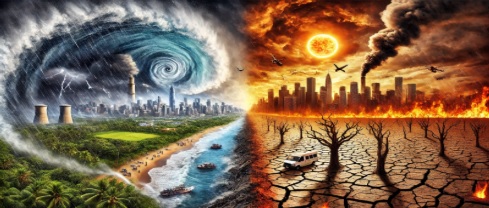Why in the NEWS?
- During 1993-2023, India ranked sixth among the top 10 countries affected by extreme weather events.

Key Points:
- According to the Climate Risk Index (CRI), a total of more than 400 extreme events were recorded in India.
- These events caused at least 80,000 deaths.
- They caused a total economic loss of $180 billion.
What will you read next in this topic?
- Major Extreme Weather Events:
- Global impacts:
- Impact of extreme weather events in 2022
- Factors of Extreme Weather Events
- Efforts of India and the world to prevent extreme weather events
Major Extreme Weather Events:
Floods:
- Devastating floods occurred in 1993, 1998, 2013, and 2019, causing massive devastation.
Heatwaves:
- Extreme temperatures in 2002, 2003, 2015 killed thousands of people.
Cyclones:
- 1998: Gujarat Cyclone, which caused massive damage in coastal areas.
- 1999: Odisha Super Cyclone, which killed thousands of people and caused massive devastation.
- 2014: Cyclone Hudhud, which proved to be devastating for Andhra Pradesh and Odisha.
- 2020: Cyclone Amphan, which caused massive devastation in Bengal and Odisha.
Abnormal heat:
- Temperatures reached 50 degrees Celsius in 1998, 2002, 2003, 2015.
- These heatwaves killed many people and caused water crisis.
Global impacts:
Mortality:
- Extreme weather events caused more than 765,000 deaths.
- Most of these deaths were caused by storms, heatwaves and floods.
Economic losses:
- Globally, these events have caused losses of more than $4.2 trillion.
- This amount is equal to the entire gross domestic product (GDP) of Germany.
Increasing incidence:
- According to scientists, climate change and global warming have increased both the number and intensity of extreme weather events.
Affected areas:
- Extreme heat, cyclones, forest fires, floods and droughts have caused disasters all over the world, the impact of which has been seen more in developing countries.
Social and environmental impacts:
- Crop production has declined drastically, threatening food security.
- Millions of people have been displaced, increasing the number of environmental refugees.
- Biodiversity has been lost, threatening the existence of many species.
- The health crisis is exacerbated because extreme weather events are accelerating the spread of infectious diseases.
Impact of extreme weather events in 2022
- Pakistan, Belize, and Italy were most affected.
- Greece, Spain, Puerto Rico, the United States, Nigeria, Portugal, and Bulgaria were also affected.
- Heatwaves caused the most deaths.
- Followed by floods, droughts, storms, and wildfires.
- The 2022 European heatwave was the main cause of high heatwave deaths.
Factors of Extreme Weather Events
Climate change and global warming
- Emissions of greenhouse gases (CO₂, methane) are increasing the Earth's temperature.
- Warmer atmosphere holds more moisture, increasing the incidence of heavy rainfall and floods.
Increase in sea surface temperature
- Warming of oceans is producing more energetic cyclones and storms.
- Warmer sea water increases the rate of evaporation, increasing the likelihood of heavy rainfall and floods.
Deforestation and land use change
- Deforestation disturbs the climate balance, affecting the rainfall cycle.
- Urbanization and concrete structures absorb heat, increasing the "heat island effect".
Aerosols and pollution
- Air pollution increases fine particles in the atmosphere, which can affect monsoon and rainfall systems.
- Aerosols can affect the formation of clouds, which leads to changes in the intensity of rainfall.
Natural climate cycles (El Niño and La Niña)
- El Niño: Abnormal heat in the Pacific Ocean changes rainfall patterns, causing droughts and floods in some places.
- La Niña: A drop in sea temperature increases cyclones and cold storms.
Melting of glaciers and polar ice
- Melting of ice in the Himalayas and the Arctic is causing sea levels to rise, increasing coastal flooding and the intensity of cyclones.
- Melting of ice is causing an imbalance in freshwater sources, increasing the incidence of drought.
Agriculture and water crisis
- Extreme heat and drought are affecting crop production, increasing food insecurity.
- Drought conditions are worsened by a drop in groundwater levels.
Changes in jet stream and atmospheric circulation
- Changes in the speed and direction of the jet stream are causing the weather system to become unstable.
- This sometimes leads to excessive rainfall, sometimes sudden cold or extreme heat events.
Efforts of India and the world to prevent extreme weather events
- Many important steps are being taken in India and globally to deal with extreme weather events.
- These efforts are focused on mitigating climate change, reducing carbon emissions and implementing adaptation strategies.
India's efforts:
- Promotion of renewable energy
- India has set a target of generating 500 gigawatts of renewable energy by 2030.
- The use of solar energy and wind energy is being promoted.
- The "International Solar Alliance" (ISA) was established by India in 2015.
- Reduction in carbon emissions
- India has set a target of achieving net-zero carbon emissions by 2070.
- Many missions are being run under the "National Action Plan on Climate Change" (NAPCC).
- The FAME scheme has been implemented to promote electric vehicles (EVs).
- Water Conservation and Green Campaign
- Under the "Namami Gange Program", efforts are being made to clean and revive the Ganga River.
- Water conservation is being promoted through the "Jal Shakti Abhiyan" and "Catch the Rain" campaigns.
- "Green India Mission" has been implemented for large-scale tree plantation and protection of forests.
- Disaster Management and Forecasting System
- Accurate weather forecasting and warning systems have been developed by the Indian Meteorological Department (IMD).
- Preparedness to deal with disasters has been strengthened through the National Disaster Management Authority (NDMA).
Efforts at the global level:
- Paris Agreement (2015)
- 195 countries signed this agreement in 2015, which aims to limit global temperature rise to 1.5°C.
- It has given a commitment to developed countries to provide climate finance.
- United Nations Sustainable Development Goals (UN SDGs)
- Several goals have been set to tackle climate change by 2030.
- These include clean energy, sustainable agriculture, water conservation and carbon reduction.
- Carbon Credits and Emissions Trading
- Many countries have implemented carbon credit systems, encouraging industries to reduce carbon emissions.
- The European Union (EU) and other countries have introduced carbon trading markets.
- Climate Finance and Aid
- Developed countries have promised to provide $100 billion in financial assistance every year to developing countries to tackle climate change.
- The Green Climate Fund and other international financial institutions are contributing to this assistance.
|
Q. India got which rank in the list of countries affected by extreme weather events during 1993-2023?
(a) Fourth
(b) Sixth
(c) Seventh
(d) Tenth
|


